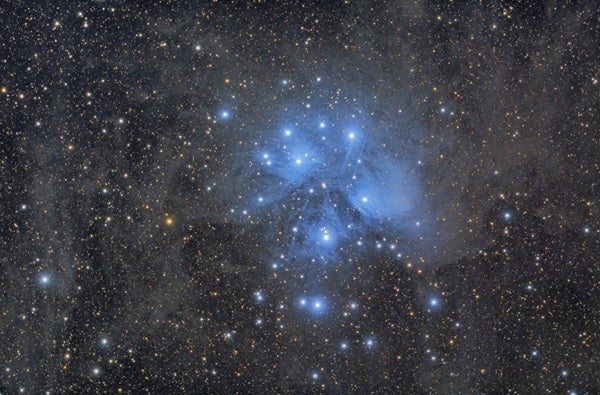Two of the finest deep-sky objects shine prominently on evenings in late February. The Pleiades and Hyades star clusters appear high in the southwest as darkness falls and remain conspicuous until midnight. The Pleiades, also known at the Seven Sisters and M45, looks like a small dipper to the naked eye. The larger Hyades forms the V-shaped head of Taurus the Bull. Although both look nice with your eyes alone, binoculars show them best.
This is a great morning to check out the planetary alignment before dawn. Mars, Jupiter, and Saturn spread out 19° along the ecliptic — the path of the Sun across our sky that the planets follow closely — with Mars highest, Jupiter 10° to its lower left, and Saturn 9° farther on. All three rise before 5 a.m. local time and appear prominent above the southeastern horizon an hour before sunup. Magnitude –2.0 Jupiter gleams brightest, with Saturn (magnitude 0.7) and Mars (magnitude 1.1) appearing more than 10 times dimmer. Because of their low altitude, none of the three looks spectacular through a telescope, though that will change dramatically as they climb higher this spring and summer.
Sunday, March 1
Comet PanSTARRS (C/2017 T2) glows at 9th magnitude this week as it makes its way northward through the constellation Cassiopeia. Tonight might be your best chance to see it, however, because the waxing Moon will spread more light across the evening sky as the week progresses. PanSTARRS is visiting the inner solar system from the distant Oort Cloud and currently lies just a few degrees west of the beautiful and picturesque Heart and Soul nebulae (IC 1805 and IC 1848, respectively). Although this region of sky remains visible all night, it lies highest in the northwest during the early evening hours.
Monday, March 2
You can find the First Quarter Moon high in the south as darkness falls, then watch as it sinks toward the western horizon before setting around 1:30 a.m. local time. Our satellite officially reaches First Quarter phase at 2:57 p.m. EDT. The Moon spends the night among the background stars of central Taurus the Bull.
The variable star Algol in Perseus reaches minimum brightness at 7:45 p.m. EST, when it shines at magnitude 3.4. If you start viewing as soon as darkness falls, you can watch it more than triple in brightness (to magnitude 2.1) over the course of about five hours. This eclipsing binary star runs through a cycle from minimum to maximum and back every 2.87 days. Algol appears high in the west after sunset and sinks slowly toward the northwestern horizon after midnight.
Tuesday, March 3
The Big Dipper’s familiar shape climbs steadily higher in the northeast on March evenings. One of the sky’s finest binocular double stars marks the bend of the dipper’s handle. Mizar shines at 2nd magnitude, some six times brighter than its 4th-magnitude companion, Alcor. Even though these two are not physically related, they make a fine sight through binoculars. (People with good eyesight often can split the pair without optical aid.) A small telescope reveals Mizar itself as double — and these components do orbit each other.
Wednesday, March 4
The solar system’s brightest asteroid is 4 Vesta, and it is conveniently located halfway to the zenith in the west-southwest during the early evening hours this week. You can find it lurking among the background stars of western Taurus the Bull. Vesta glows at magnitude 8.3, which makes it a reasonably easy target through binoculars from the country and a snap to see with a small telescope from the suburbs. Tonight offers a prime viewing opportunity because the asteroid lies 2.8° due north of the 4th-magnitude star 5 Tauri.
One of the sky’s most familiar constellations rules March evenings from dusk until around midnight local time. Orion the Hunter appears at its highest in the south as darkness falls but grows more prominent once twilight fades away. If you’ve watched Orion over the years, you might notice that it doesn’t look quite the same now. Ruddy Betelgeuse, which marks one of the Hunter’s shoulders, is a mere shadow of its normal self. Fortunately, the red supergiant star has started to rebound from its historic low of magnitude 1.6 during February’s second week. It already has brightened by 0.1 to 0.2 magnitude, and astronomers expect it to continue this trend until it reaches its normal brightness of around magnitude 0.6
Friday, March 6
One of the sky’s largest asterisms — a recognizable pattern of stars separate from a constellation’s form — occupies center stage on March evenings. To trace the so-called Winter Hexagon, start with southern Orion’s luminary, Rigel. From there, the hexagon makes a clockwise loop. The second stop is brilliant Sirius in Canis Major. Next, pick up Procyon in the faint constellation Canis Minor, then the twins Castor and Pollux in Gemini, followed by Capella in Auriga, Aldebaran in Taurus, and finally back to Rigel.
Saturday, March 7
Venus gleams in the western sky after sunset. The brilliant planet stands out just a half-hour after sundown, when it stands nearly 40° above the horizon, and it is still 25° high once darkness fully settles in. Venus remains on display until after 9:30 p.m. local time. Shining at magnitude –4.3, it is by far the brightest point of light in the night sky. A telescope reveals the planet’s disk, which spans 20″ and appears 60 percent lit. And as a bonus, Venus serves as a guide to the solar system’s seventh planet, Uranus, tonight and tomorrow night. Because the distant world glows feebly at magnitude 5.9, you’ll need binoculars or a telescope to spot it. Once the sky grows dark tonight, center Venus in the field of view and then search for Uranus 2.2° to its southeast (to the left when viewed from mid-northern latitudes). Don’t confuse the ice giant world with a similarly bright star even closer to Venus. Uranus lies about twice as far from Venus as that star. You can remove any doubt by targeting the objects through a telescope. Only Uranus will show a 3.4″-diameter disk and conspicuous blue-green color.
Sunday, March 8
Venus and Uranus appear equally as close this evening as they did yesterday, though their relative positions have changed. Tonight, Uranus lies just a bit east of due south (to the lower left) of Venus. By the way, the actual conjunction between these two planets occurs at 11 a.m. EDT tomorrow, but the two will stand 2.6° apart by the time darkness falls.
For most people in the United States and Canada, daylight saving time begins at 2 a.m. local time this morning. Set your clocks ahead one hour.
Neptune is in conjunction with the Sun at 8 a.m. EDT. The distant planet is hopelessly lost in the solar glare but will return to view before dawn in late April.












